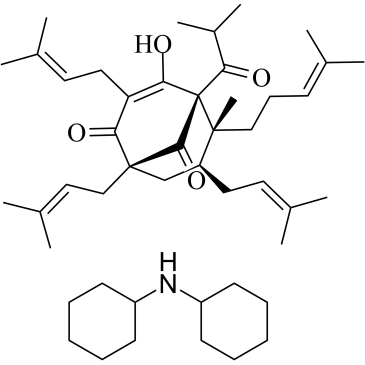Hyperforin dicyclohexylammonium salt

Hyperforin dicyclohexylammonium salt structure
|
Common Name | Hyperforin dicyclohexylammonium salt | ||
|---|---|---|---|---|
| CAS Number | 238074-03-8 | Molecular Weight | 718.10300 | |
| Density | N/A | Boiling Point | N/A | |
| Molecular Formula | C47H75NO4 | Melting Point | N/A | |
| MSDS | Chinese USA | Flash Point | N/A | |
| Symbol |



GHS05, GHS07, GHS09 |
Signal Word | Danger | |
Use of Hyperforin dicyclohexylammonium saltHyperforin dicyclohexylammonium salt (Hyperforin DCHA) is a transient receptor canonical 6 (TRPC6) channels activator. Hyperforin dicyclohexylammonium salt modulates Ca2+ levels by activating Ca2+-conducting non-selective canonical TRPC6 channels. Hyperforin dicyclohexylammonium salt shows antidepressant effect[1][2]. |
| Name | N-cyclohexylcyclohexanamine,(1R,5R,6R,7S)-2-hydroxy-6-methyl-1,3,7-tris(3-methylbut-2-enyl)-6-(4-methylpent-3-enyl)-5-(2-methylpropanoyl)bicyclo[3.3.1]non-2-ene-4,9-dione |
|---|---|
| Synonym | More Synonyms |
| Description | Hyperforin dicyclohexylammonium salt (Hyperforin DCHA) is a transient receptor canonical 6 (TRPC6) channels activator. Hyperforin dicyclohexylammonium salt modulates Ca2+ levels by activating Ca2+-conducting non-selective canonical TRPC6 channels. Hyperforin dicyclohexylammonium salt shows antidepressant effect[1][2]. |
|---|---|
| Related Catalog | |
| In Vitro | Hyperforin dicyclohexylammonium salt (Hyperforin DCHA) has a multi-directional mechanism of action. It blocks conductance of ligand-gated (GABA, NMDA, and AMPA receptors) and voltage-gated channels (Ca2+, K+, and Na+)[2]. |
| References |
| Molecular Formula | C47H75NO4 |
|---|---|
| Molecular Weight | 718.10300 |
| Exact Mass | 717.57000 |
| PSA | 83.47000 |
| LogP | 12.62200 |
| InChIKey | KJVNMVCMFQAPDM-DNSWOBEMSA-N |
| SMILES | C1CCC(NC2CCCCC2)CC1.CC(C)=CCCC1(C)C(CC=C(C)C)CC2(CC=C(C)C)C(=O)C1(C(=O)C(C)C)C(=O)C(CC=C(C)C)=C2O |
| Symbol |



GHS05, GHS07, GHS09 |
|---|---|
| Signal Word | Danger |
| Hazard Statements | H302-H314-H400 |
| Precautionary Statements | P273-P280-P305 + P351 + P338-P310 |
| RIDADR | UN 1759 8 / PGIII |
|
Knockdown of oncogenic KRAS in non-small cell lung cancers suppresses tumor growth and sensitizes tumor cells to targeted therapy.
Mol. Cancer Ther. 10 , 336-46, (2011) Oncogenic KRAS is found in more than 25% of lung adenocarcinomas, the major histologic subtype of non-small cell lung cancer (NSCLC), and is an important target for drug development. To this end, we g... |
|
|
Reciprocal regulation of c-Src and STAT3 in non-small cell lung cancer.
Clin. Cancer Res. 15 , 6852-61, (2009) Signal transducer and activator of transcription-3 (STAT3) is downstream of growth factor and cytokine receptors, and regulates key oncogenic pathways in non-small cell lung cancer (NSCLC). Activation... |
|
|
Alternative splicing of caspase 9 is modulated by the phosphoinositide 3-kinase/Akt pathway via phosphorylation of SRp30a.
Cancer Res. 70 , 9185-96, (2010) Increasing evidence points to the functional importance of alternative splice variations in cancer pathophysiology. Two splice variants are derived from the CASP9 gene via the inclusion (Casp9a) or ex... |
| hyperforin dicyclohexylammonium salt |
| Hyp-DCHA Hyperforin-DCHA |
| Hyp-DCHA |
| Hyperforin-DCHA |